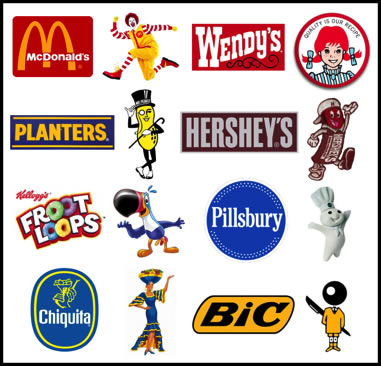Mascot Logo Design – 10 Best Blogs to Follow

The popularity of Mascots, continue to grow and expand as part of marketing and advertising. Marketers realize that mascot logo design and implementation is an important part of any marketing strategy.
Why? because we are visual creatures. Thus providing visual stimulation to our buyers is important. Besides with mascots we can humanize our products and services. In today’s society, mascots provide us more flexibility when it comes to being politically correct. Mascots help create a real connection between your company and customer.
A mascot can be the ultimate game-changer, separating your company from the crowded field of competition.
First of all, lets review the use of a mascot logo and mascot logo design. A logo especially a mascot logo is not a brand and a nickname is not a mascot but all three, when designed and utilized properly can strengthen your brand. So what is a mascot: an animal, person, or thing adopted by a group (team, company, organization, product etc.) as its representative symbol and supposed to bring good luck: For example the U.S. Navy mascot is a goat.
Here is a list of blogs that can assist you when considering a mascot logo design.
- 35 Logos Designs that Make Use of Mascots – When it comes to logo designs, there are plenty of different styles and approaches that can be used. Of course, the best approach will vary from one project and one business to the next.
- Should Your Brand Have a Mascot? – Mascots have to be unique and relatable in order to appeal to a qualified audience. Animals can be vulnerable, relatable, adorable and funny — sometimes all at the same time. Audiences overwhelmingly respond to life-like mascots in advertisements and mascots have undergone a renaissance since the digital age.
- The Symbol of Success: Building Brand Identity Through Logos and Mascots – Marketing isn’t just about words. Visual images are compelling and often are easier to remember than a product pitch. A symbol that represents your business, such as a logo or mascot, sticks in the customer’s mind and helps build brand identity.
- How Mascots Work, And How To Pick A Memorable One – Mascots, aka spokes-creatures, are branding elements that can help people better remember your company and products. Often based on people, animals, or objects, mascots enable your target audience to better identify, remember, and understand your company and products.
- Mascots Are Brands’ Best Social-Media Accessories – Brand mascots are rebounding as marketers redeploy old characters in new ways, create fresh ones from scratch and use digital media to spin out rich storylines not possible in the past, when critters and cartoon characters were pretty much confined to TV. While it might be too early to declare a full-fledged mascot revival, brand characters are undoubtedly regaining attention.
- Mascots as Brand Amplifiers – Mascots…those lovable anthropomorphized characters who push cereal, tunafish, and dough products…are more than just cute tools for marketing to children. Sure, they can be very effective in appealing to moms and kids, but more than that, they are guerrilla marketers in clever packaging. Mascots used to populate television commercials. Think Trix Rabbit, Charlie the Tuna, or the Pillsbury Doughboy. Now, mascots have jumped off the small screen, where it is hard (and expensive) to build a story in 30 seconds, and into our smart phones where social media can be used to create rich back-stories and exciting adventures that appeal to all ages.
- 5 Reasons Why Mascots Are Particularly Relevant for Brands with Dual Mom/Child Targets – As you may have read in Ad Age, brand mascots are enjoying a new resurgence and offering more competitive advantage with the advent of digital media. I recently had the opportunity to speak with branding expert Colleen Fahey, US Managing Director of Sixieme Son, the audio branding agency, about the topic of mascots.
- A Question of Character: Branding with Mascots – I’m proud to be an Ithaca Bomber. For four years, I cheered for Ithaca College‘s football team, with the help of “Bomberman”, a pep squad member dressed as a World War II bomber pilot. Imagine my horror when I read of recommendations to replace Bomberman with an incinerated bird, a flying small nervous prey animal, or a monster that hides in a swamp. Apparently a task force deemed Bomberman politically incorrect as it tied its hands with requirements that “war-related proposals will not be considered” despite being called the Bombers. Needless to say, suggestions for a pacifist mascot bombed.
- Social Media Reveals – What’s the True Value of a Mascot? – Social media enables consumers to engage with brands. This is the Holy Grail for brands in the social space – and many marketers have tapped into the effective strategy of using brand mascots to engage with their online community, to build and nurture relationships with their consumers, and provide useful industry related tips and humourous stories.
- The Best and Worst Brand Mascots of All Time – Tony the Tiger. Count Chocula. The Keebler Elves. Brand mascots have been a part of our lives since we were little kids looking for the next sugar-packed treat to enjoy. But they extend beyond the hyper little kid target market. You know the Michelin Man? That half tire, half ghost-looking giant that represents, well, Michelin? He’s been around since the late 1800s! And though his look has changed since then (and now we have animation to bring him to life) there are many brand mascots that have been going strong for years. At the same time, there are other mascots that brands seem to hold on to for years despite an overwhelming distaste among the general public for their wily ways. This post will examine both extremes — the brand mascots we all love, and the ones we all love to hate. Let’s take a look, shall we?
